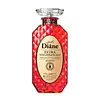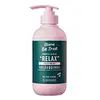What's inside
What's inside
 Key Ingredients
Key Ingredients

No key ingredients
 Benefits
Benefits

 Concerns
Concerns

 Ingredients Side-by-side
Ingredients Side-by-side

Water
Skin ConditioningSodium C14-16 Olefin Sulfonate
CleansingLauryl Betaine
CleansingCocamide Methyl Mea
Asparagopsis Armata Extract
Skin ProtectingPropanediol
SolventGamma-Docosalactone
Skin ConditioningQuaternium-33
PEG-32
HumectantPEG-6
HumectantDipropylene Glycol
HumectantGlucosyl Hesperidin
HumectantButylene Glycol
HumectantHydrolyzed Rice Protein
Skin ConditioningGlycerylamidoethyl Methacrylate/Stearyl Methacrylate Copolymer
HumectantSodium Hyaluronate
HumectantSorbitol
HumectantPrunus Domestica Seed Extract
EmollientAscophyllum Nodosum Extract
Skin ConditioningPisum Sativum Sprout Extract
Skin ConditioningKeratin
Skin ConditioningChamomilla Recutita Flower Extract
MaskingSpiraea Ulmaria Flower Extract
Skin ConditioningIsomalt
HumectantPolyquaternium-10
Polyquaternium-7
Hydrolyzed Collagen
EmollientHydrolyzed Keratin
HumectantHydrolyzed Silk
HumectantPCA Ethyl Cocoyl Arginate
MoisturisingHydrolyzed Silk Pg-Propyl Methylsilanediol
Skin ConditioningBiotin
AntiseborrhoeicPouteria Sapota Seed Oil
EmollientPhytosteryl/Octyldodecyl Lauroyl Glutamate
Skin ConditioningSclerocarya Birrea Seed Oil
HumectantTheobroma Grandiflorum Seed Butter
Skin ConditioningMangifera Indica Seed Oil
EmollientUbiquinone
AntioxidantGlycine Soja Sterols
EmollientCeramide Ng
Skin ConditioningArgania Spinosa Kernel Oil
EmollientCeramide Ag
HumectantCeramide NP
Skin ConditioningCeramide AP
Skin ConditioningCeramide EOP
Skin ConditioningChenopodium Quinoa Seed Oil
EmollientCarapa Guaianensis Seed Oil
Skin ConditioningAdansonia Digitata Seed Oil
EmollientSodium Chloride
Masking1,2-Hexanediol
Skin ConditioningCholesterol
EmollientSalicylic Acid
MaskingO-Cymen-5-Ol
AntimicrobialTea-Cocoyl Glutamate
CleansingPotassium Cocoyl Hydrolyzed Keratin
Skin ConditioningQuaternium-18
Behentrimonium Chloride
PreservativePEG-60 Hydrogenated Castor Oil
EmulsifyingGlycerin
HumectantPropylene Glycol
HumectantCitric Acid
BufferingTocopherol
AntioxidantDisodium EDTA
Sodium Benzoate
MaskingPhenoxyethanol
PreservativeParfum
MaskingCaramel
Cosmetic ColorantWater, Sodium C14-16 Olefin Sulfonate, Lauryl Betaine, Cocamide Methyl Mea, Asparagopsis Armata Extract, Propanediol, Gamma-Docosalactone, Quaternium-33, PEG-32, PEG-6, Dipropylene Glycol, Glucosyl Hesperidin, Butylene Glycol, Hydrolyzed Rice Protein, Glycerylamidoethyl Methacrylate/Stearyl Methacrylate Copolymer, Sodium Hyaluronate, Sorbitol, Prunus Domestica Seed Extract, Ascophyllum Nodosum Extract, Pisum Sativum Sprout Extract, Keratin, Chamomilla Recutita Flower Extract, Spiraea Ulmaria Flower Extract, Isomalt, Polyquaternium-10, Polyquaternium-7, Hydrolyzed Collagen, Hydrolyzed Keratin, Hydrolyzed Silk, PCA Ethyl Cocoyl Arginate, Hydrolyzed Silk Pg-Propyl Methylsilanediol, Biotin, Pouteria Sapota Seed Oil, Phytosteryl/Octyldodecyl Lauroyl Glutamate, Sclerocarya Birrea Seed Oil, Theobroma Grandiflorum Seed Butter, Mangifera Indica Seed Oil, Ubiquinone, Glycine Soja Sterols, Ceramide Ng, Argania Spinosa Kernel Oil, Ceramide Ag, Ceramide NP, Ceramide AP, Ceramide EOP, Chenopodium Quinoa Seed Oil, Carapa Guaianensis Seed Oil, Adansonia Digitata Seed Oil, Sodium Chloride, 1,2-Hexanediol, Cholesterol, Salicylic Acid, O-Cymen-5-Ol, Tea-Cocoyl Glutamate, Potassium Cocoyl Hydrolyzed Keratin, Quaternium-18, Behentrimonium Chloride, PEG-60 Hydrogenated Castor Oil, Glycerin, Propylene Glycol, Citric Acid, Tocopherol, Disodium EDTA, Sodium Benzoate, Phenoxyethanol, Parfum, Caramel
Water
Skin ConditioningCetearyl Alcohol
EmollientDimethicone
EmollientSteartrimonium Chloride
PreservativeEthylhexyl Palmitate
EmollientParfum
MaskingPhenoxyethanol
PreservativeHydrogenated Castor Oil Isostearate
Skin ConditioningBis-Behenyl/Isostearyl/Phytosteryl Dimer Dilinoleyl Dimer Dilinoleate
EmollientIsopropyl Alcohol
SolventRicinus Communis Seed Oil
MaskingCetrimonium Chloride
AntimicrobialGlucose
HumectantDimethiconol
EmollientHydroxyethylcellulose
Emulsion StabilisingDicocodimonium Chloride
EmulsifyingGlyceryl Tri-Hydrogenated Rosinate
EmollientDisodium EDTA
Lactic Acid
BufferingSodium Lactate
BufferingPrunus Amygdalus Dulcis Oil
Skin ConditioningArgania Spinosa Kernel Oil
EmollientSimmondsia Chinensis Seed Oil
EmollientButylene Glycol
HumectantGlycerin
HumectantHydrolyzed Pea Protein
EmollientHydrolyzed Quinoa
Skin ConditioningPolyepsilon-Lysine
Skin ConditioningHydrolyzed Corn Protein
Skin ConditioningBrassica Oleracea Acephala Leaf Extract
HumectantWater, Cetearyl Alcohol, Dimethicone, Steartrimonium Chloride, Ethylhexyl Palmitate, Parfum, Phenoxyethanol, Hydrogenated Castor Oil Isostearate, Bis-Behenyl/Isostearyl/Phytosteryl Dimer Dilinoleyl Dimer Dilinoleate, Isopropyl Alcohol, Ricinus Communis Seed Oil, Cetrimonium Chloride, Glucose, Dimethiconol, Hydroxyethylcellulose, Dicocodimonium Chloride, Glyceryl Tri-Hydrogenated Rosinate, Disodium EDTA, Lactic Acid, Sodium Lactate, Prunus Amygdalus Dulcis Oil, Argania Spinosa Kernel Oil, Simmondsia Chinensis Seed Oil, Butylene Glycol, Glycerin, Hydrolyzed Pea Protein, Hydrolyzed Quinoa, Polyepsilon-Lysine, Hydrolyzed Corn Protein, Brassica Oleracea Acephala Leaf Extract
Ingredients Explained
These ingredients are found in both products.
Ingredients higher up in an ingredient list are typically present in a larger amount.
You may know this ingredient as argan oil. Argan Oil has antioxidant, hydrating, and soothing properties.
Studies have shown argan oil can help fight again radical damage from the sun. This makes it effective at preventing hyperpigmentation.
Large amounts of vitamin E found in argan oil helps the skin retain water. Argan oil also contains fatty acids such as linoleic acid, oleic acid, and palmitic acid. It is also a good source of lipids.
Another benefit of argan oil is skin-soothing. It can help reduce inflammation-related skin symptoms.
Argan Oil is effective at regulating sebum production in pores. This can make it effective at treating hormonal acne.
Traditionally, argan oil was used for its antibacterial and antifungal properties. However, argan oil contains fatty acids that may make it not fungal-acne safe.
Argan Trees are native to Morocco.
Learn more about Argania Spinosa Kernel OilButylene Glycol (or BG) is used within cosmetic products for a few different reasons:
Overall, Butylene Glycol is a safe and well-rounded ingredient that works well with other ingredients.
Though this ingredient works well with most skin types, some people with sensitive skin may experience a reaction such as allergic rashes, closed comedones, or itchiness.
Learn more about Butylene GlycolDisodium EDTA plays a role in making products more stable by aiding other preservatives.
It is a chelating agent, meaning it neutralizes metal ions that may be found in a product.
Disodium EDTA is a salt of edetic acid and is found to be safe in cosmetic ingredients.
Learn more about Disodium EDTAGlycerin is already naturally found in your skin. It helps moisturize and protect your skin.
A study from 2016 found glycerin to be more effective as a humectant than AHAs and hyaluronic acid.
As a humectant, it helps the skin stay hydrated by pulling moisture to your skin. The low molecular weight of glycerin allows it to pull moisture into the deeper layers of your skin.
Hydrated skin improves your skin barrier; Your skin barrier helps protect against irritants and bacteria.
Glycerin has also been found to have antimicrobial and antiviral properties. Due to these properties, glycerin is often used in wound and burn treatments.
In cosmetics, glycerin is usually derived from plants such as soybean or palm. However, it can also be sourced from animals, such as tallow or animal fat.
This ingredient is organic, colorless, odorless, and non-toxic.
Glycerin is the name for this ingredient in American English. British English uses Glycerol/Glycerine.
Learn more about GlycerinParfum is a catch-all term for an ingredient or more that is used to give a scent to products.
Also called "fragrance", this ingredient can be a blend of hundreds of chemicals or plant oils. This means every product with "fragrance" or "parfum" in the ingredients list is a different mixture.
For instance, Habanolide is a proprietary trade name for a specific aroma chemical. When used as a fragrance ingredient in cosmetics, most aroma chemicals fall under the broad labeling category of “FRAGRANCE” or “PARFUM” according to EU and US regulations.
The term 'parfum' or 'fragrance' is not regulated in many countries. In many cases, it is up to the brand to define this term.
For instance, many brands choose to label themselves as "fragrance-free" because they are not using synthetic fragrances. However, their products may still contain ingredients such as essential oils that are considered a fragrance by INCI standards.
One example is Calendula flower extract. Calendula is an essential oil that still imparts a scent or 'fragrance'.
Depending on the blend, the ingredients in the mixture can cause allergies and sensitivities on the skin. Some ingredients that are known EU allergens include linalool and citronellol.
Parfum can also be used to mask or cover an unpleasant scent.
The bottom line is: not all fragrances/parfum/ingredients are created equally. If you are worried about fragrances, we recommend taking a closer look at an ingredient. And of course, we always recommend speaking with a professional.
Learn more about ParfumPhenoxyethanol is a preservative that has germicide, antimicrobial, and aromatic properties. Studies show that phenoxyethanol can prevent microbial growth. By itself, it has a scent that is similar to that of a rose.
It's often used in formulations along with Caprylyl Glycol to preserve the shelf life of products.
Water. It's the most common cosmetic ingredient of all. You'll usually see it at the top of ingredient lists, meaning that it makes up the largest part of the product.
So why is it so popular? Water most often acts as a solvent - this means that it helps dissolve other ingredients into the formulation.
You'll also recognize water as that liquid we all need to stay alive. If you see this, drink a glass of water. Stay hydrated!
Learn more about Water